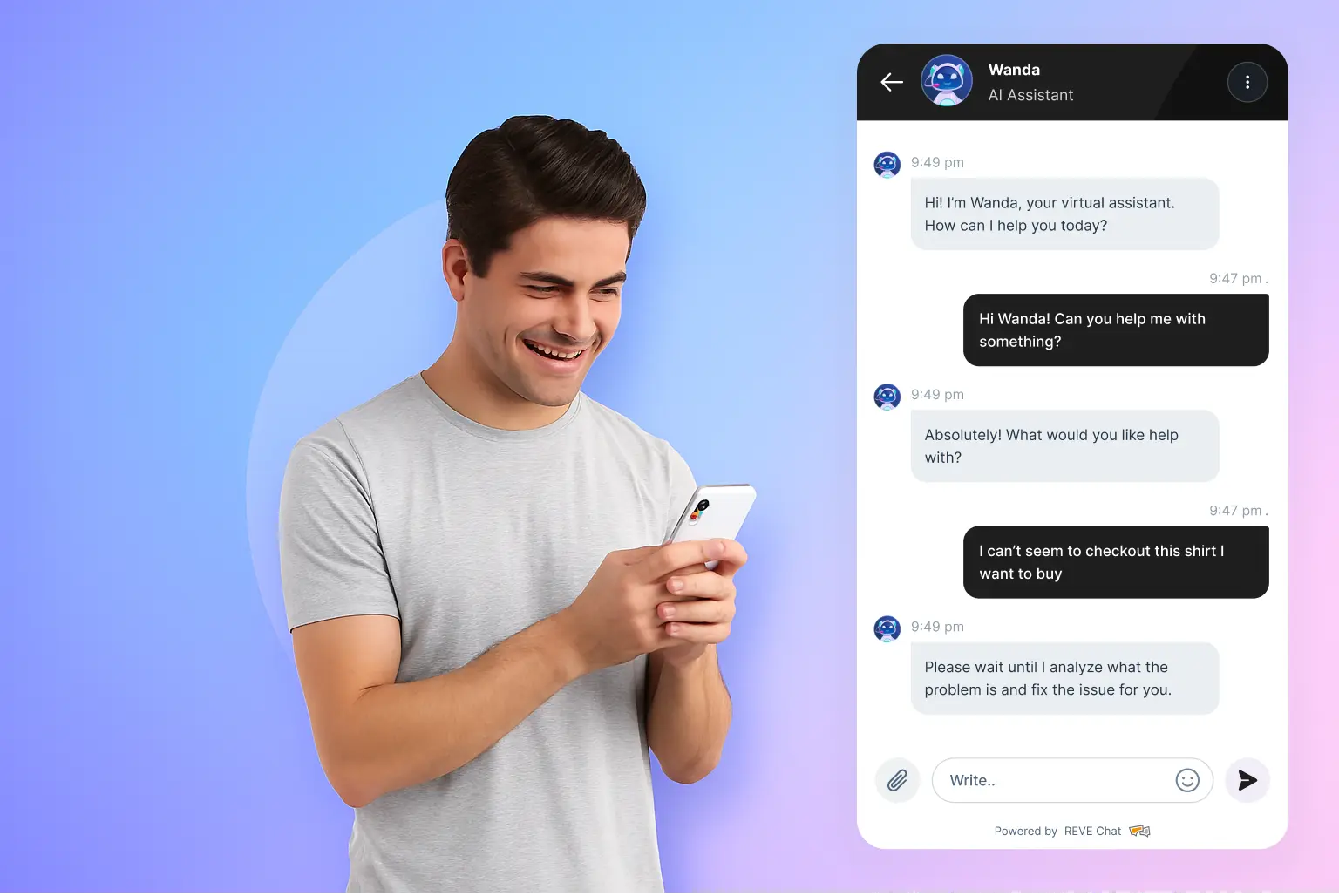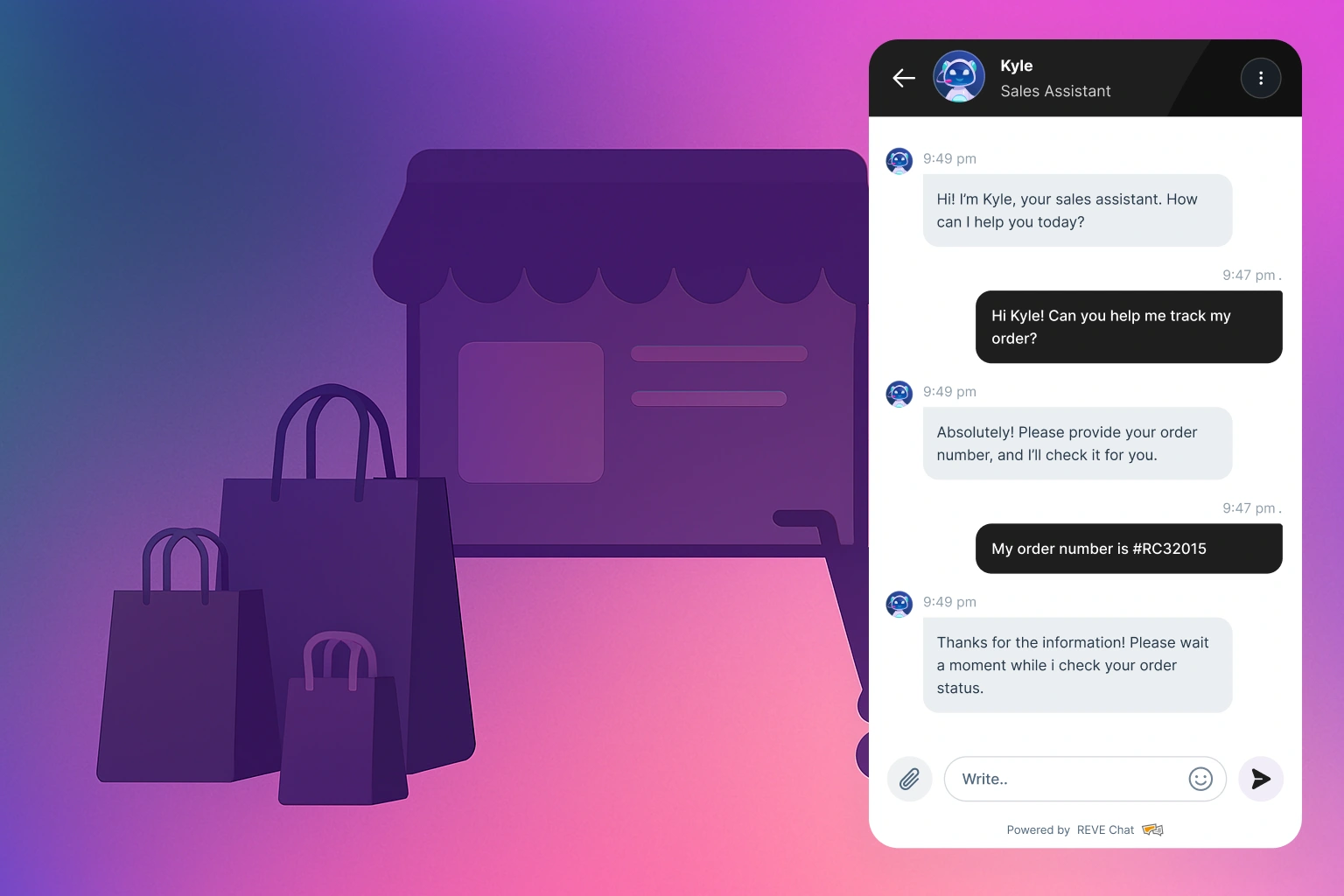10 AI Chatbot Examples That Boost Sales, Support, and Satisfaction
- July 22, 2025
- 14 mins read
- Listen
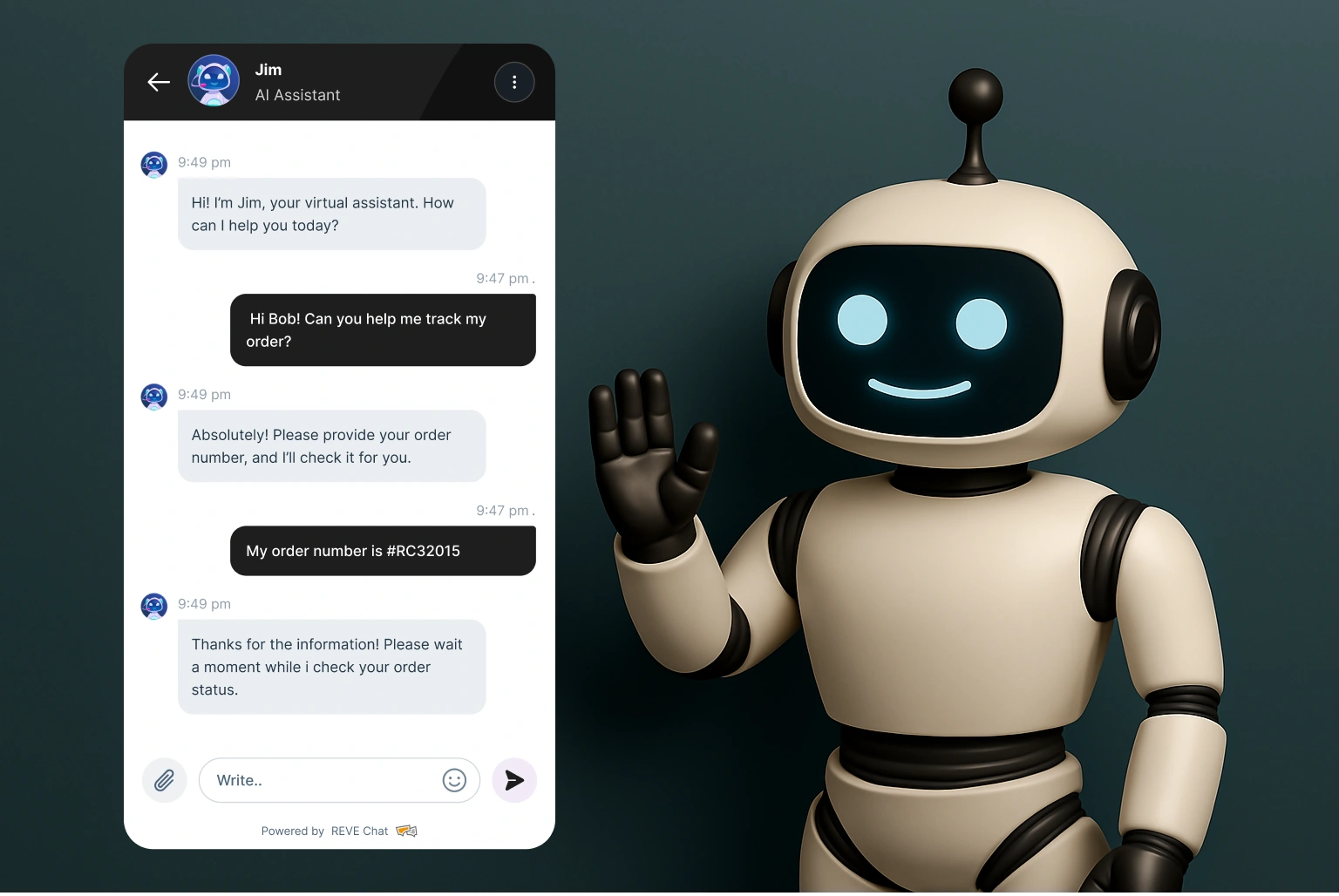
Do you know chatbots are taking the business world by storm, popping up on websites, apps, and social media with unstoppable momentum? But are you tapping into their full potential, or are you missing out on a game-changer?
Well, many businesses are yet to tap into the real power and potential of chatbots. If you’re one of them, worry not, as we know where you’re going wrong. To ease your worries, we bring to you chatbot examples from across industries so that you can clearly understand how other businesses are mastering them.
Let’s dive into these inspiring AI chatbot examples and unlock endless possibilities for your business!
How Businesses Use Chatbots?
In recent times, chatbots have become an important tool for businesses to perform many tasks and serve customers well. From delivering quick responses to ensuring round-the-clock availability, from engaging customers better to driving sales, you can find examples showcasing various ways in which businesses benefit from chatbots.
Let’s look at how organizations across industries use chatbots –
- 24/7 Availability – With chatbots, businesses can offer round-the-clock support to their customers. Bots are used to provide instant assistance to customers, quickly answer their queries, and resolve their issues without human intervention, all of this outside of regular business hours.
- Customer Support – Chatbots are being used to automate routine queries and tasks, thereby reducing the dependency on large customer support teams. This brings operational costs down and frees human agents to focus more on other significant customer issues.
- Consistent and Error-Free Service – Chatbots can deliver consistent service all the time, as they don’t get tired like humans and are not immune to distractions. Businesses often use AI chatbots to deliver reliable responses to customers with every interaction.
- Lead Generation and Qualification – Using the bot, it becomes easy to engage visitors, collect information from them, and qualify leads. All this is possible because bots can ask pre-defined questions. This is how businesses can improve conversion rates.
- Offer Personalized Assistance – With advanced technologies like AI (Artificial Intelligence) and NLP (Natural Language Processing), bots can understand customer queries, anticipate their needs, and offer accurate responses. They can even generate personalized product recommendations for customers.
- Improved Customer Experience – With chatbots, businesses can easily engage with customers on various platforms such as websites, mobile apps, and other social media platforms. Bots can deliver prompt automated responses to customer queries, leading to a more interactive experience.
- Communicate in Customer’s Language – Many chatbots are equipped to provide customer service in multiple languages, making them ideal for businesses with a global customer base. By offering support in customers’ native languages, a business can eliminate language barriers and enhance their experience.
- Reports and Insights – Chatbots can collect valuable data on multiple areas such as customer preferences, buying behavior, browsing patterns, past interactions, agent performances, etc, helping businesses improve products, services, and marketing strategies.
10 Best AI Chatbot Examples for Your Business
Let’s take a close look at examples from across industries to reveal the fact that chatbots are used in diverse ways by businesses.
While some companies use it to engage customers better, others may use it to add efficiency to marketing processes.
In a way, the use of chatbots depends on specific business requirements, and it varies from industry to industry.
Let’s look at the best AI chatbot examples for businesses from different segments –
1. STC Kuwait: Telecom Chatbot
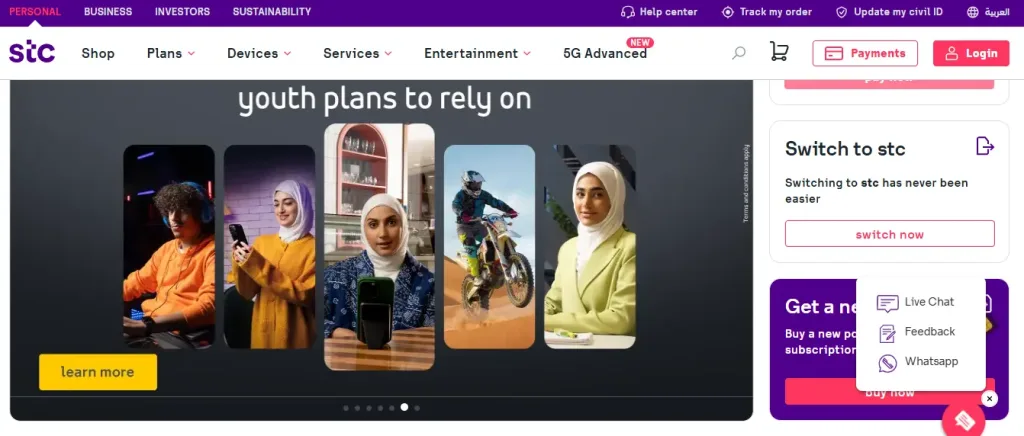
Kuwait’s telecom giant, stc, powers the largest 5G network and unmatched customer service. By integrating REVE Chat’s AI chatbot, it delivers instant, context-aware responses in multiple languages.
This ensures customers stay connected with minimal wait times.
Use Cases:
- Bilingual Support: Provides responses in Arabic and English for diverse customers.
- Context-Driven Answers: Delivers accurate, tailored replies based on query context.
- Multi-Channel Integration: Works across websites, apps, and social media platforms.
Benefits:
- Reduced Wait Times: Speeds up query resolution, improving customer satisfaction.
- Scalable Service: Handles a wide range of queries with high accuracy.
- Consistent Experience: Ensures seamless support across all customer touchpoints.
Example Interaction:
- User Inquiry: “What’s my current data plan?”
- Chatbot Response: “You’re on the 5G Unlimited Plan. Want details on usage or upgrades?”
2. Canadian Hearing: Accessibility Chatbot

Canadian Hearing Services, a champion for Deaf and hard-of-hearing Canadians, revolutionizes accessibility with its AI chatbot powered by REVE Chat.
Supporting diverse communication needs, it offers instant access to vital services. This bot empowers users with tailored solutions for hearing health and inclusion.
Use Cases:
- Voice and Video Call Support: Enables direct communication via voice or video for accessibility.
- LiveChat and Chatbot Integration: Combines real-time chat with automated responses for flexibility.
- ASL and Hearing Aid Assistance: Facilitates inquiries about ASL classes and hearing aid services.
Benefits:
- Comprehensive Support: Offers counseling, hearing tests, and aural rehabilitation for holistic care.
- Accessible Learning: Simplifies booking for ASL classes and hearing assessments, enhancing inclusion.
- Device Management: Streamlines requests for hearing aid fittings, maintenance, or replacements.
Example Interaction:
- User Inquiry: “Can I book a hearing test?”
- Chatbot Response: “Absolutely! I can schedule a hearing test for you. Prefer an in-person or remote appointment?”
3. Transcom Digital: E-Commerce Chatbot
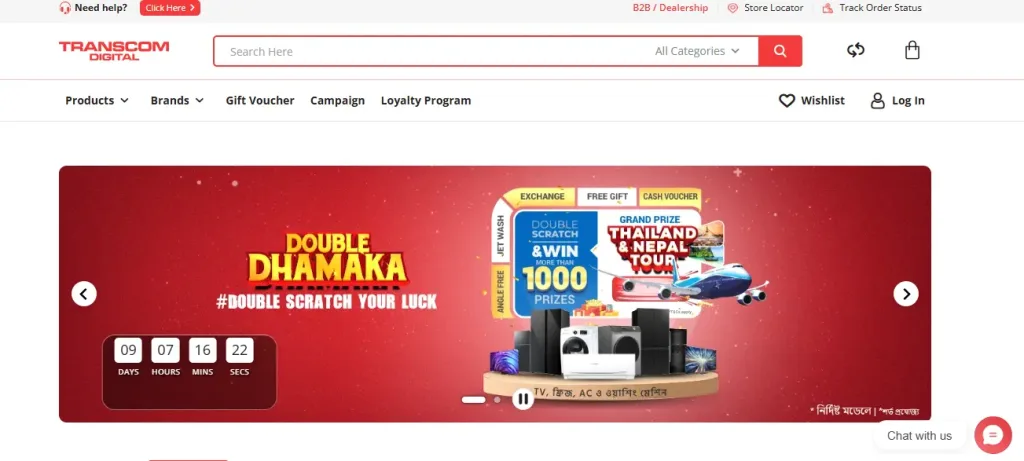
Transcom Digital, a leading electronics retailer, transforms shopping with its AI chatbot through REVE Chat. It’s from guiding purchases to resolving post-sale issues; it delivers seamless customer experiences.
This bot is a powerhouse for driving sales and support in the digital marketplace.
Use Cases:
- Multi-Platform Engagement: Operates on web, Facebook, and WhatsApp for a broad reach.
- Canned Responses and Chat Tags: Ensures quick, categorized replies for efficient query handling.
- CSAT Form Integration: Collects customer satisfaction feedback to improve services.
Benefits:
- Boosted Sales: Supports showroom, B2B, and online orders with tailored promotions like EMI or discounts.
- Robust After-Sales Support: Resolves complaints, delivery issues, and OTP problems swiftly.
- Personalized Offers: Delivers targeted deals like Midnight Madness or EID offers, enhancing conversions.
Example Interaction:
- User Inquiry: “What’s the status of my TV order?”
- Chatbot Response: “Your order is out for delivery! Expected arrival tomorrow. Want to track it or explore our EMI offers?”
4. INAI: Customer Service Chatbot
INAI, Mexico’s beacon of transparency, empowers citizens by making government information accessible. Facing linguistic diversity, it turned to AI to bridge communication gaps.
By integrating REVE Chat’s multilingual chatbot, INAI delivers seamless support, ensuring every citizen’s voice is heard.
Use Cases:
- Multilingual Support: Offers seamless assistance in Spanish and English, catering to diverse populations.
- 24/7 Query Handling: Responds instantly to citizen inquiries, even outside business hours.
- Integration with Platforms: Embeds effortlessly into websites and apps for accessible support.
Benefits:
- Inclusive Communication: Breaks language barriers, ensuring all citizens can access information.
- Enhanced Satisfaction: Boosts user trust with quick, consistent responses, achieving a 45% increase in satisfaction.
- Resource Efficiency: Automates common queries, freeing staff for complex tasks.
Example Interaction:
- User Inquiry: “How can I access government records?”
- Chatbot Response: “You can request records via our portal. Would you like the steps in Spanish or English?”
5. Legrand: AI-Powered Chatbot
Legrand, a global leader in electrical solutions, redefines customer support with cutting-edge technology.
Its AI chatbot, powered by REVE Chat, tackles queries with precision and speed.
This innovation transforms user engagement, making technical support effortless and reliable.
Use Cases:
- NLP-Driven Responses: Understands complex queries using advanced Natural Language Processing.
- Automated Troubleshooting: Guides users through solutions for technical issues.
- Cross-Platform Availability: Operates on websites and mobile apps for consistent support.
Benefits:
- High Query Resolution: Handles 85% of customer inquiries without human intervention.
- Cost-Effective Support: Reduces reliance on large support teams, optimizing resources.
- Improved Trust: Delivers fast, error-free responses, enhancing customer confidence.
Example Interaction:
- User Inquiry: “My smart switch isn’t working.”
- Chatbot Response: “Let’s troubleshoot: Is the switch powered on? Try resetting it by holding the button for 10 seconds.”
6. Slush: FAQ Chatbot
Slush, the global hub for entrepreneurial events, thrives on connecting innovators. Its Jenny chatbot tackles attendee queries with speed and precision.
Available 24/7, it ensures a seamless event experience for thousands worldwide.
Use Cases:
- Instant FAQ Responses: Answers common event-related questions in real-time.
- Scalable Interaction: Manages thousands of queries from large audiences.
- Mobile and Web Access: Available 24/7 on Slush’s website and app.
Benefits:
- Reduced Workload: Handles 64% of support requests, easing staff burden.
- Increased Engagement: Drives 55% more conversations with attendees.
- Event Efficiency: Provides quick answers, enhancing the attendee experience.
Example Interaction:
- User Inquiry: “What’s the event schedule?”
- Chatbot Response: “The schedule is live on our app! Want me to send you the link or highlight key sessions?”
7. Vainu: Lead Generation Chatbot
Vainu, a data analytics powerhouse, revolutionizes lead generation with its VainuBot.
This chatbot engages website visitors with dynamic conversations, turning casual browsers into qualified leads. It’s a game-changer for sales teams seeking efficiency.
Use Cases:
- Targeted Questioning: Asks qualifying questions to identify potential leads.
- Interactive Engagement: Offers dynamic, conversational lead capture.
- Demo Scheduling: Collects contact info to book demos or send reports.
Benefits:
- Higher Conversion Rates: Outperforms traditional forms with engaging interactions.
- Qualified Leads: Filters prospects effectively, improving sales efficiency.
- User-Friendly Process: Simplifies lead capture for website visitors.
Example Interaction:
- User Inquiry: “Tell me about your analytics services.”
- Chatbot Response: “Our platform tracks market trends. Interested in a demo? Please share your email.”
8. KLM Royal Dutch Airlines: Multilingual FB Bot
KLM Royal Dutch Airlines soars in customer service with its AI-powered BlueBot (BB).
Handling thousands of weekly social media queries streamlines travel updates and support. This chatbot makes every journey smoother for global travelers.
Use Cases:
- Social Media Integration: Operates on FB Messenger for real-time travel updates.
- Multilingual Responses: Handles queries in multiple languages for global travelers.
- Transaction Support: Sends booking confirmations and boarding passes.
Benefits:
- Scalable Interactions: Manages 16,000 weekly queries, boosting efficiency.
- Enhanced Traveler Experience: Delivers personalized updates, increasing engagement by 40%.
- Time Savings: Frees agents to focus on complex travel issues.
Example Interaction:
- User Inquiry: “What’s my flight status?”
- Chatbot Response: “Your flight KL123 is on time. Want your boarding pass sent to Messenger?”
9. L’Oreal: AI Recruiting Assistant
L’Oréal, the beauty industry titan, transforms recruitment with Mya, its AI assistant.
Managing millions of applications, Mya engages candidates with personalized support. It’s a masterclass in streamlining HR for global talent acquisition.
Use Cases:
- Multi-Channel Communication: Engages candidates via SMS, email, and social platforms.
- Candidate Screening: Administers assessments and ranks applicants by metrics.
- Application Updates: Provides real-time progress alerts to candidates.
Benefits:
- Efficient Recruitment: Handles 1 million applications annually with 92% engagement.
- High Satisfaction: Achieves near 100% candidate satisfaction with timely responses.
- Streamlined HR: Allows recruiters to focus on interviews and offers.
Example Interaction:
- User Inquiry: “What’s the status of my internship application?”
- Chatbot Response: “Your application is under review. Expect an update by next week. Need interview tips?”
10. Babylon Health: Healthcare Bot
Babylon Health brings healthcare to your fingertips with its AI chatbot. By analyzing symptoms and guiding users to the next steps, it personalizes care at scale.
This bot empowers patients with instant, reliable health advice.
Use Cases:
- Symptom Analysis: Compares user symptoms to a medical database for guidance.
- Appointment Booking: Facilitates scheduling of doctor consultations.
- Personalized Health Advice: Tailors responses based on the user’s medical history.
Benefits:
- Streamlined Care: Simplifies access to health advice and appointments.
- Personalized Experience: Enhances user trust with tailored health insights.
- Efficient Triage: Guides users to appropriate next steps, reducing unnecessary visits.
Example Interaction:
- User Inquiry: “I have a headache and fever.”
- Chatbot Response: “These could indicate a flu. Rest and hydrate. Want to book a video consultation?”
What Makes a Great Chatbot?
To maximize the potential of chatbots, businesses must focus on key features that ensure effectiveness and user satisfaction.
A great chatbot is more than just a tool. It’s a strategic asset that enhances customer engagement and streamlines operations.
Here are the essential elements that define a top-tier chatbot:
1. Intuitive User Interface
A great chatbot offers a simple and user-friendly interface that makes interactions seamless. It guides users naturally through conversations, ensuring even first-time users can navigate effortlessly.
Clear prompts and minimal complexity enhance user adoption and satisfaction.
2. Advanced AI and NLP Capabilities
Powered by AI and Natural Language Processing, a chatbot should understand and respond to diverse user queries accurately.
This allows it to handle complex conversations, interpret intent, and provide relevant answers, creating a human-like interaction experience.
3. Seamless Integration Across Platforms
A chatbot must integrate smoothly with websites, mobile apps, and social media platforms like Facebook or WhatsApp.
This ensures consistent user experiences across channels, allowing businesses to meet customers where they are most active.
4. Scalability and Reliability
Great chatbots can handle high volumes of interactions without performance issues, scaling effortlessly during peak times.
Reliable uptime and fast response times are critical to maintaining trust and delivering consistent service to users.
5. Data Security and Privacy
A top chatbot prioritizes user data protection, complying with regulations like GDPR or CCPA. Secure data handling and transparent privacy policies build customer trust. It ensures sensitive information remains safe during interactions.
6. Analytics and Continuous Improvement
The best chatbots provide actionable insights through data analytics, tracking user behavior, and interaction patterns.
This enables businesses to refine responses, optimize performance, and tailor strategies to meet evolving customer needs.
Tips for Effective Chatbot Implementation for Your Business
A successful chatbot implementation requires careful planning and alignment with your business goals.
A well-executed chatbot can transform customer interactions and streamline operations. But it demands strategic focus.
Here are key tips to ensure your chatbot delivers maximum value:
- Define Clear Objectives – Begin by identifying specific goals for your chatbot, such as enhancing customer support or increasing lead generation. Clear objectives guide the design and functionality of the chatbot. It addresses your business’s unique needs effectively.
- Understand Your Audience – Analyze your customers’ preferences, behaviors, and pain points to tailor the chatbot’s tone and responses. A chatbot that resonates with your audience’s language and expectations fosters better engagement and trust.
- Start Small and Scale Gradually – Begin with a focused scope, like handling FAQs or basic tasks, to test and refine the chatbot. Gradually expand its capabilities as you gather feedback, ensuring reliability and user satisfaction at every stage.
- Leverage AI and NLP for Smarter Interactions – Use AI and Natural Language Processing to enable your chatbot to understand complex queries and provide accurate responses. This enhances the user experience by making conversations feel natural and intuitive.
- Ensure Seamless Handoff to Human Agents – Design your chatbot to recognize when a query requires human intervention and smoothly transfer the conversation. This hybrid approach maintains customer satisfaction for complex issues while leveraging automation for routine tasks.
- Monitor and Optimize Performance – Regularly analyze chatbot interactions to identify areas for improvement, such as response accuracy or user engagement. Use analytics to refine scripts and update the chatbot to meet evolving customer needs.
Conclusion
Chatbots are a powerful addition to a business’s toolkit, but their effectiveness lies in knowing how and when to use them to enhance the customer experience.
Just as a single spice does not go well with every dish, the roles of human agents and chatbots must be thoughtfully balanced.
After getting inspiration from these chatbot examples, a business can consider building a dynamic conversational chatbot by using REVE Chat.
It is one of the best chatbot-building platforms that offers industry-focused, personalized, and pre-defined templates to build a chatbot with ease.
So, Sign Up today to build a chatbot by using the REVE Chatbot platform.
Frequently Asked Questions
Businesses in retail, healthcare, telecom, and hospitality see significant benefits from chatbots. They streamline customer support, boost sales, and enhance engagement. Any industry with high customer interaction volumes can leverage chatbots for efficiency.
Costs vary based on complexity, from free basic platforms to custom solutions costing thousands. Many providers, like REVE Chat, offer scalable plans.
Advanced chatbots with NLP can manage complex queries by understanding intent. They provide accurate responses or escalate to human agents seamlessly. This ensures a smooth customer experience even for intricate issues.
Modern chatbots prioritize security with encryption and compliance to GDPR/CCPA standards. Choosing a reputable platform ensures data protection. Always verify the provider’s privacy policies before implementation.
Chatbots offer instant, 24/7 responses, reducing wait times and personalizing interactions. They handle routine queries consistently, freeing agents for complex tasks.
Chatbots typically use Natural Language Processing (NLP) and Machine Learning (ML) to understand and respond to human languages conversationally.
An AI-powered chatbot for customer service uses machine learning and NLP to provide personalized and accurate responses to customer inquiries, handle complex issues, and offer support around the clock.
The main purpose of a chatbot is to automate and enhance customer interactions, providing immediate support and information, improving user experience, and increasing operational efficiency.



